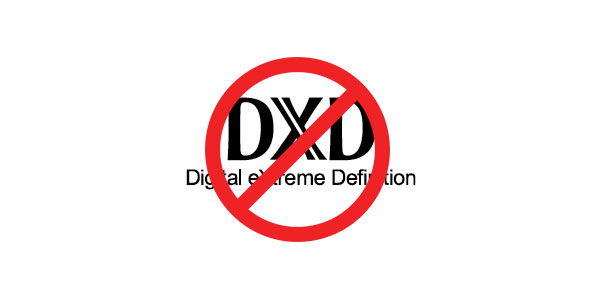Highest Ever Quality Digital Music Format?
I have to give Peter Scheelke kudos for getting his new Promate site on the map…and his ability to generate some buzz among audiophiles. The news arrived in a Press Release, via several emails, an online article, interviews, and even a private communication from a close friend whose company produces music servers. The Press Release prominently displays the DXD logo with the sub line “Digital eXtreme Definition”. I just love the name that Merging Technologies came up with to support the DSD format back when SACDs were initially introduced (Remember that you can’t work on DSD natively). DXD – Digital eXtreme Definition makes it sound like a major new audio format…when in fact, DXD is not a format at all and IMHO should be relegated to the trash heap of stupid marketing ideas.
DXD is a marketing term. It was coined to be deliberately similar to DSD (just look at the logo) and helps elevate DSD and SACD in the marketplace. It’s simply PCM…no more and no less. And when Peter announced on November 11th from Copenhagen, Denmark that consumer could now download the “Highest Ever Quality Digital Music Format” it’s all marketing spin. Stereophiles’ Jason Victor Serinus posted an article just a few days ago proclaiming Promate as “the world’s first DXD download store”, which is factually incorrect. Norway’s 2L has been making its DXD recordings available for years. I’ve downloaded a number of them.
When I posted a comment on the Stereophile site, Peter replied:
“The name DXD (Digital eXtreme Definition) is justified by the definition of DXD: 352.8 kHz/24 bit in the converters and 352.8 kHz/32 or 64 bit floating point in the DAW.
In contrast to PCM DXD doesn’t have a brick-wall filter in the AD converter? An aliasing filter is not necessary, as the analog amplitude at 150 kHz is lower than the noise floor of the AD converter.
An aliasing filter creates a pre/post ringing in the signal, and a steep filter has more ringing than a less steep filter. In our AX24 converter (Yes, I was co-founder of DAD) we only deployed a very soft filter from 130 kHz with minimal pre/post ringing.”
The definition of DXD? It’s merely a higher sampling rate (which is …as we’ve seen recently in several posts…completely unnecessary) in the converters and longer word lengths in the DAW…something that’s been true of PCM since I first started assembling CD back in 1989 with my new Sonic Solution editing system. Nothing there to justify the use of a new term.
It’s true that DXD doesn’t have a brickwall filter in the AD converter, fair enough. But neither do AD converters that are running at 96 kHz/24-bits. The design of filtering (apodizing etc) has virtually done away with pre-and post ringing, which actually only happens at or near the Nyquist frequency anyway…do you think you can hear a pre-ring at 47 kHz?
The DXD spectra that I’ve looked at have lots of ultrasonic noise…so maybe the use of a filter is a good thing. The folks at Sony certainly thought so with the introduction of DSD.
I’m glad that Promates has entered the marketplace for high-resolution audio. But let’s get on target and leave the hyperbole behind. Nothing to see here…please move along.


Which analog-to-digital converters don’t have a brickwall filter when operating at 96 kHz?
The fact that they are still talking about brick wall converters, just shows how much they are focused on CD bitrates, which is a bit of a giveaway that DXD is born of SACD/DSD even though it is conventional PCM. SACD was focused on CD bitrate multiplication of 32 times 44.1 equals 1411, because it was seen as a better CD — even the name being Super Audio CD.
They even chose their sampling rate to be “8 times CD” 352.8 instead of the conventional 384 kHz for PCM based on doubling 192.
It’s all about how much better it is than CD. 8 more bits, 8 times the sampling rate. We’re lucky it wasn’t called DX8CD-D!
It’s bizarre and unnecessary.
Thanks Grant…I have to guess that Promates will continue to push DXD because it is their thing. The hype is unwarranted.
I have seen these advertisements and agree their claims are quite extraordinary.
Irregardless of the digital encoding, I always wonder just what was the original source format.
I can say what happened in the Promates recordings…but it really doesn’t matter. I’m in the middle of downloading the DXD file and the 88.2 file of the Neilsen. I’ll do an analysis and listening test and report back. I guess the Promates people won…they got $50 from me.
I’ve been reading Dr. Waldrep’s posts for a few years now, and I’ve acquired a fair collection of his and others’ “better than CD” recordings. I’m a retired A/V engineer, so I didn’t just fall off the truck, but one thing I’ve never quite understood about DSD/DXD. Since it’s a “one-bit” scheme, it seems to me (and that phrase ALWAYS leaves room for my education to be improved) that it’s a delta modulation scheme.
Basically, a delta modulator’s bit tells a counter which direction to count in order to have its value match an analog input value. It was my senior project in college, and while my little 8-bit breadboard would pass spoken word, in 1978 it wasn’t anywhere near what we could call high fidelity.
So my question to anyone who might know, “Is DSD a delta modulation scheme?”
Thanks to anyone who responds.
Thanks for the post Jim…a couple of quick things. Please don’t associate DSD and DXD…one is a 1-bit world and the other is pure PCM. ANd yes, DSD is a delta sigma coding scheme Ithe articles I posted some months ago on the history of DSD might help).